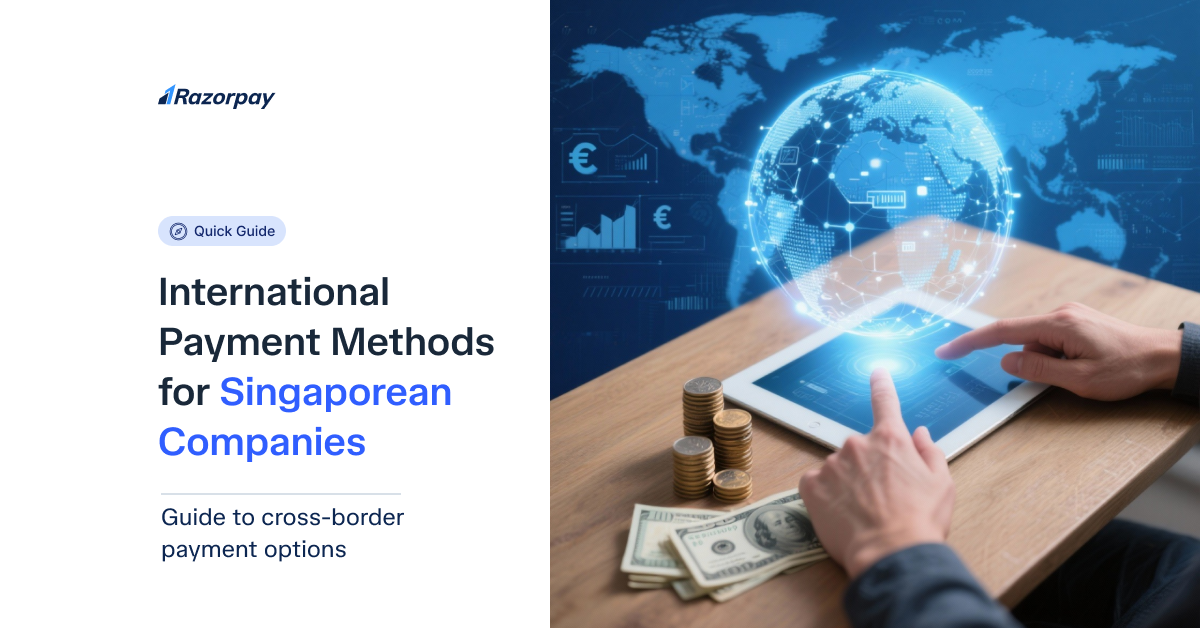For ambitious Singaporean companies, the domestic market is just the beginning. With a world-class reputation for quality and innovation, the opportunity to sell to customers across the globe has never been greater. But as you expand your reach, you face a new and critical challenge: how do you get paid?
Accepting international payments is far more complex than domestic transactions. It involves navigating a maze of different currencies, cross-border fees, varying customer preferences, and heightened security risks. Choosing the right international payment methods is a strategic decision that directly impacts your global conversion rates, operational costs, and customer trust.
This guide provides a clear roadmap for Singaporean businesses looking to venture into cross-border commerce. We will break down the most important international payment methods, explain the challenges involved, and show how a modern payment platform can make global sales simple and secure.
Key Takeaways
- Global Growth is Key: Selling internationally is a major growth lever for Singaporean businesses, but it requires a robust cross-border payment strategy.
- The Challenges are Real: Key obstacles include high currency conversion fees, complex international regulations, varying payment preferences in different countries, and a higher risk of fraud.
- Core Payment Methods: The essential international payment methods to offer are international credit/debit cards, globally recognized digital wallets, and traditional bank transfers.
- Customer Experience Matters: Displaying prices and accepting payments in your customer’s local currency is proven to increase trust and significantly boost conversion rates.
- A Unified Platform is the Solution: Partnering with a payment platform like Razorpay Singapore is the most effective way to manage the complexities of international sales, offering multi-currency support and advanced fraud detection through a single integration.
The Core Challenges of Accepting Cross-Border Payments
Before choosing the methods, it’s important to understand the hurdles.
- High FX and Hidden Fees: Traditional bank transfers (like SWIFT) often involve high “wire” fees and unfavorable foreign exchange (FX) rates, with costs being deducted by multiple intermediary banks.
- Varying Payment Preferences: While cards are popular in the US and Europe, customers in Southeast Asian markets might prefer local bank transfers or specific e-wallets. Not offering these can lead to lost sales.
- Increased Fraud Risk: International transactions are statistically at a higher risk for fraud. Verifying a customer’s identity across borders is more challenging, making robust fraud prevention tools essential.
- Regulatory and Compliance Burdens: Each country has its own set of rules governing payments and data privacy. Navigating this complex web of regulations can be a major challenge for a growing business.
Top 3 International Payment Methods for Your Business
To effectively sell globally, you need to offer a mix of methods that provide security and convenience for your international customers.
1. International Credit and Debit Cards
This is the most widely accepted method for cross-border e-commerce.
- How it Works: Customers can pay using their Visa, Mastercard, or American Express cards, just as they would on a local website. The payment is processed through the global card networks.
- For Your Business: This is a must-have. A payment platform can help you securely accept cards from customers worldwide and manage the settlement in Singapore Dollars (SGD), protecting you from currency fluctuations. Always ensure transactions are protected by 3D Secure to minimize fraud.
2. Global Digital Wallets
Digital wallets offer a secure and convenient way for customers to pay without entering their card details on your site.
- How it Works: Customers pay using their existing account with a globally recognized provider. The transaction is authenticated within the wallet’s secure environment. PayPal is the most well-known example for cross-border transactions.
- For Your Business: Offering a trusted digital wallet can significantly increase conversion rates, as customers feel more secure paying through a familiar service. It signals that your business is a legitimate global seller.
3. International Bank Transfers (SWIFT)
For large B2B transactions, traditional bank transfers remain a common, albeit slower, method.
- How it Works: A customer initiates a “wire transfer” from their bank to yours using the SWIFT network.
- For Your Business: This method is best reserved for high-value invoices. It can be slow (taking 3-5 business days), expensive due to intermediary bank fees, and difficult to reconcile manually. Modern payment platforms are now offering more efficient, digital alternatives for B2B payments.
Did You Know?
A study on international e-commerce found that showing prices in a customer’s local currency can increase conversion rates by up to 40%.
This psychological comfort of seeing a familiar currency symbol and avoiding mental math is a powerful driver of trust and sales.
How a Payment Platform Simplifies Global Commerce
Managing all these methods and challenges individually is a logistical nightmare. This is where a modern payment platform becomes an essential partner for global expansion.
A platform like Razorpay Singapore is designed to take the complexity out of cross-border commerce.
- Multi-Currency Support: We enable you to display prices and accept payments in over 100 currencies. This means a customer in the US sees prices in USD, while a customer in Malaysia sees prices in MYR. We handle the currency conversion and settle the final amount to you in SGD.
- Unified Payment Options: Through a single integration, you can offer international cards, digital wallets, and other popular regional payment methods, all managed from one central dashboard.
- Advanced International Fraud Detection: Our system uses AI and machine learning to analyze transactions for cross-border fraud signals, such as IP address mismatches or unusual purchasing patterns, helping to block fraudulent orders before they become a problem.
- Simplified Reconciliation: All your international sales, fees, and settlements are tracked in one place, providing a clear and accurate view of your global revenue without the headache of manual reconciliation.
Ready to Take Your Singaporean Business Global?
Don’t let the complexity of cross-border payments limit your growth. Expand your reach with a partner that makes international sales simple and secure.
Learn how Razorpay Singapore can power your international payments.
Conclusion
For Singaporean companies, the global market represents a vast ocean of opportunity. Success in this arena depends on providing an international customer experience that is as seamless and trustworthy as your domestic one. By choosing the right mix of payment methods and leveraging a powerful, unified payment platform, you can overcome the challenges of cross-border commerce and confidently turn your global ambitions into reality.
Frequently Asked Questions (FAQs) for Singapore Merchants
What is the most important feature to look for in an international payment provider?
Multi-currency support is arguably the most critical feature. The ability to let customers pay in their local currency while you receive funds in SGD simplifies the process for everyone and is a major driver of international sales conversions.
What is the cheapest way to accept international payments?
There is no single “cheapest” way, as it depends on the transaction value and country. While bank transfers may seem cheap, hidden fees can make them expensive. For most online businesses, using a payment platform that offers competitive, transparent rates for card and wallet processing is the most cost-effective and scalable solution.
How does currency conversion work with a payment platform?
When a customer pays in a foreign currency (e.g., 100 USD), the payment platform processes the transaction, applies a competitive foreign exchange rate at the time of settlement, and deposits the final converted amount (e.g., ~135 SGD) into your Singapore bank account, minus the processing fees.




